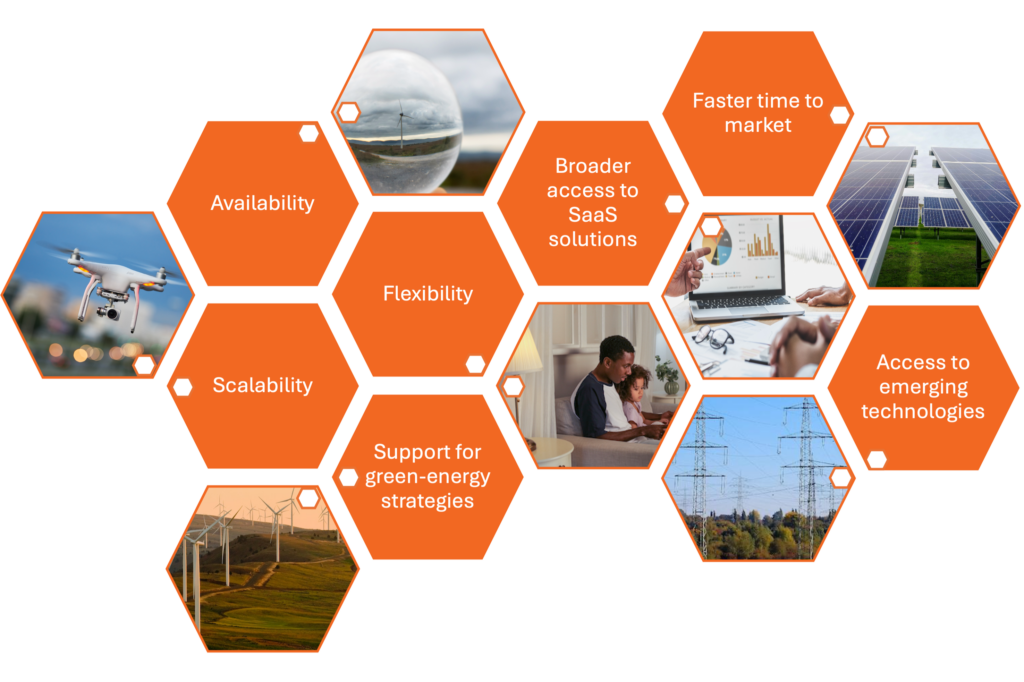Balancing innovation and regulation with cloud migration

Discover how utilities can approach their cloud migration challenges to ensure a smooth transition, enabling enhanced efficiency and innovation.
A recent Harvard Business Review survey revealed that 67 percent of senior executives said their organization had fast-tracked its plans for cloud adoption, up from just over half the year before (Harvard, 2022, p. 2). As cloud adoption across industries continues to accelerate, the utilities industry is no exception.
With more utility providers looking to improve operational efficiency and drive innovation, interest in migrating applications to the cloud is growing throughout the sector. As they pursue the cloud’s promises of scalability, flexibility, and disaster recovery capabilities, utilities face a series of pertinent questions, including
- Why consider cloud? What is the business value of rehosting and repurchasing (e.g. SaaS) to leverage cloud solutions?
- How will NERC’s (North American Electric Reliability Corporation) regulations—and the possibility of changing guidance—impact decision making?
- How do we prioritize applications/workloads for migration?
- How do we get started with strategic planning for a cloud migration roadmap?
In this article, we’ll offer insights on how utilities can address these questions to enable a seamless migration to cloud-based operations.
Why should utilities migrate applications to the cloud?
Facing challenges surrounding the integration of distributed energy resources (DERs) and renewables, shifting regulatory requirements, and pressure from customers to lower rates, utility companies are increasingly turning to cloud solutions. The benefits that utilities find in cloud technologies offer solutions to these pressing concerns:
Scalability
The integration of DERs and renewable energy sources introduces variability into the power generation ecosystem, making the cloud’s scalability essential for adjusting computing resources in response to fluctuating energy supplies.
Flexibility
With regulatory landscapes evolving and customer expectations escalating, the cloud gives utilities the agility needed to quickly adapt to new compliance requirements and to deploy new services and improvements that enhance the customer experience.
Availability
Safety and disaster recovery capabilities are primary concerns for utility providers. The robust disaster recovery features of cloud platforms are critical for maintaining uninterrupted service during natural disasters or cyber-attacks, ensuring data integrity and continuous utility operations.
Broader access to SaaS solutions
As many software vendors no longer support on-premises versions of their solutions, migrating to the cloud gives utilities access to the full array of SaaS solutions available, in addition to simplifying management of licenses.
Faster time to market
Because cloud hosting enables on-demand resources and automation (e.g. CI/CD), it creates an environment for rapid, seamless implementations. Utilities can leverage this capability for solutions developed in house as well as for implementation of off-the-shelf platforms.
Access to emerging technologies
Through cloud platforms, utilities gain access to artificial intelligence, machine learning, data analytics, and other advanced technologies that drive innovation and offer opportunities to gain a competitive edge. They can quickly spin up cloud-native solutions and offerings to enable industry-specific use cases, including numerous analytics capabilities.
Support for green-energy strategies
Through resource optimization, energy-efficient data centers, virtualization, efficient hardware utilization, and multi-tenancy, cloud computing supports utilities in advancing their green-energy objectives.
By leveraging the cloud, utilities can navigate the challenges of the modern energy landscape more effectively—and position themselves at the forefront of innovation, enhancing grid reliability and customer service while supporting environmental sustainability goals.
Depending on the unique challenges and constraints faced by an individual provider, the value proposition of cloud may include some or all of the above factors, with emphasis shifting based on the specific problems that need to be addressed.
Key benefits of cloud migration for utilities
How do NERC CIP regulations impact cloud migrations?
In the transition towards cloud-based applications, utility companies face the critical task of aligning with NERC regulations. Pivotal for utilities integrating DERs and renewable energy into their grids, NERC’s guidelines focus on ensuring the secure and reliable operation of the bulk power system as providers adopt more sophisticated technologies.
Applications significantly impacted by NERC standards typically involve critical operational and management functions. Strategies for maintaining compliance throughout the cloud migration journey include
- Security assessments: Conducting thorough evaluations of cloud services to identify and mitigate potential risks
- Adherence to NERC Critical Infrastructure Protection (CIP) standards: Following specific guidelines designed to protect the bulk power system from security breaches (more on these below)
- Continuous monitoring: Implementing ongoing surveillance of cloud-based systems to detect vulnerabilities and enable prompt remediation)
NERC CIP requires that certain applications be hosted on the premises. These standards apply to applications in which changes made to data within them impact the grid directly within 15 minutes. Some applications may fall outside of this time requirement but do impact the grid directly and therefore fall into a grey area. Thus, many applications may be subject to NERC CIP, incurring high maintenance costs for utilities.
NERC has recognized the value of cloud computing for the utility sector and supports the use of cloud technology for its cost benefits and efficiency, while remaining justifiably concerned about security and safety. NERC requires that utilities:
- Implement stringent security measures to mitigate risks associated with third-party data storage services.
- Ensure cloud-based storage of Bulk Electric System Cybersecurity Information (BCSI) meets NERC’s approved security protocols.
- Follow revised standards (CIP-004-7 and CIP-011-3) that clarify the use of third-party cloud solutions for storing BCSI.
Prioritizing NERC compliance enables utilities to leverage the benefits of cloud computing without compromising the bulk power system’s security and reliability. By adopting comprehensive security strategies and continuous compliance monitoring, utilities can navigate the complexities of cloud adoption within a regulated environment.
For more information, see the NERC white paper “BES Operations in the Cloud” (NERC, 2023).
Common cloud migration decision drivers
Before committing to a cloud migration project, utility decision makers will benefit from devoting time and effort to the following considerations:
- Cost assessment: Encompasses the entire cost picture, including those concerning process standardization, capex versus opex expenditures, and the requirements of cost recovery. Note that ingress and egress charges (passing data back and forth between cloud-hosted and non-cloud-hosted apps) could make it cost prohibitive to move an app to the cloud, even if it’s not blocked for regulatory reasons.
- Regulatory and data privacy assessment: Regulation-based reasons why an application may or may not be “eligible” to move to the cloud include NERC CIP, SOC 2, and other similar requirements.
- Value assessment: Includes any business and technology value considerations that are unique to your business and to each application of cloud computing.
How to get started: our 3-stage approach
Embarking on a cloud migration journey requires a structured, strategic approach. Utilities can initiate this process through a three-stage approach to ensure a comprehensive migration path that aligns with their business goals.
Stage 1: Discovery
The first phase involves an in-depth discovery process, where utilities gather critical data and documentation on their current assets and systems. This stage includes
- Gathering all relevant data and documentation
- Developing a gap analysis of readiness assessment criteria
- Reviewing and validating the asset inventory for completeness using new readiness criteria
- Gathering business requirements
- Assessing internal and external non-functional requirements such as data management policies and regulatory requirements
These actions culminate in the creation of an asset inventory template to serve as a foundation for a comprehensive evaluation of assets based on migration readiness. This information may be managed in a project and portfolio management tool that allows for integration with data sources such as the configuration management database (CMDB), application registry, disaster recovery systems, and other data sources.
Stage 2: Roadmap development
The next stage encompasses
- Collecting migration assessment information for each application based on defined criteria
- Eliciting readiness levels and migration strategy recommendations from stakeholders
- Estimating high-level migration effort
- Identifying potential infrastructure cost-saving opportunities and potential risks
The deliverable of this phase is a detailed cloud migration roadmap, in which each application is scored against the selected readiness criteria and an effort-level overview is presented to facilitate informed decision making.
Stage 3: Business case alignment
The final stage focuses on aligning the utility’s cloud migration strategy with its overarching business goals. Key decision points requiring executive buy-in are identified, and the strategic value of cloud migration is communicated to ensure strategy alignment. The associated materials for this decision, presented either in a strategy alignment presentation or as a business case, outline the key aspects of the cloud migration plan, emphasizing its benefits and strategic importance to the executive team.
By following this three-stage approach, utilities can methodically plan and execute migration of applications to the cloud, ensuring that every step is aligned with business objectives, technical requirements, and regulatory compliance and paving the way for a successful transition to cloud-based operations.
Charting the future of utility cloud migration
As utilities navigate the complexities of cloud migration, they stand on the brink of transforming their operational landscapes. Embracing the cloud under the guidance of NERC regulations, prioritizing applications with precision, and methodically advancing through a structured migration process are essential in harnessing the cloud’s full capabilities. This strategic approach boosts operational efficiency and resilience and aligns utilities with the dynamic shifts transforming the energy sector.
Through cloud technology, utilities position themselves to meet future demands with greater flexibility, ensuring the delivery of reliable, secure, and efficient services. This journey marks a pivotal evolution in the utility industry, promising a future where innovation and sustainability stand at the forefront of energy provision.
References
Harvard Business Review Analytics Services. (2022). Accelerating Forward: The State of Cloud-Driven Transformation. https://www.splunk.com/en_us/pdfs/resources/analyst-report/hbr-the-state-of-cloud-driven-transformation-2021.pdf
NERC. (2023, September). BES Operations in the Cloud NERC Security Integration and Technology Enablement Subcommittee White Paper. https://www.nerc.com/comm/RSTC_Reliability_Guidelines/SITES_WhitePaper_BES Ops_in_Cloud.pdf
About the Authors
Alexis Sears is a Senior Manager in the Logic20/20 Digital Transformation practice. In her experience as a technical project manager and systems analyst, she has enabled change through the implementation of many customer-facing solutions.
Pradeep Balaji is a Cloud Architect in the Logic20/20’s Digital Transformation practice, with more than 10 years’ experience in the energy and utilities industry and having helped utility customers in their cloud migration journeys.






